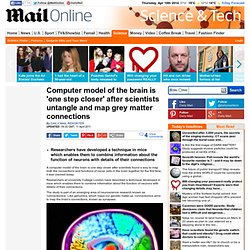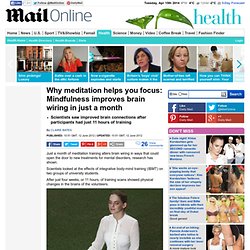

Could a brain scan tell you how smart you are? Research shows intelligence linked to strength of neural connections. By Daily Mail Reporter Published: 14:27 GMT, 2 August 2012 | Updated: 14:27 GMT, 2 August 2012 Brain scans which establish how well different regions of your brain are detected may be able to predict how intelligent you are, a new study claims.

Research suggests that 10 per cent of individual differences in intelligence can be explained by the strength of neural pathways connecting the left lateral prefrontal cortex to the rest of the brain. The findings, published in the Journal of Neuroscience, establish 'global brain connectivity' as a new approach for understanding how human intelligence relates to physiology. See how a fish thinks! Incredible video that shows a thought swimming through the brain of a Zebrafish.
Video shows the reaction in a fish's brain to the sight of foodScientists believe technology could help develop drugs or even read minds By Emily Davies Published: 21:27 GMT, 1 February 2013 | Updated: 05:02 GMT, 2 February 2013 A video showing a fish's reaction to food as a fluorescent visual representation has been published by researchers.

The short clip shows parts of the zebrafish's brain lighting up in purple as a a paramecium - a single celled organism which the fish eats - is introduced into its environment. The discovery was made by a group of scientists from Japan’s National Institute of Genetics who were the first to capture thoughts of a living creature on video in real-time. Scroll down for video. Liberals and conservatives use different parts of the brain when they make risky decisions and these regions can be used to pred. New study says while parental influence may play a role, being a Tory or a socialist changes how the brain functions The results suggest that liberals and conservatives engage in different cognitive processes when they think about risk By Daily Mail Reporter Published: 01:49 GMT, 14 February 2013 | Updated: 04:20 GMT, 14 February 2013 People at opposite ends of the political spectrum don't just have different views - they even use their brains differently.

Researchers have found liberals and conservatives use different parts of the brain when they make risky decisions and these regions can be used to predict which political party a person prefers. The new study by a team of political scientists and neuroscientists suggests that while genetics or parental influence may play a significant role, being a Tory or a socialist changes how the brain functions. Not on the same wavelength: Scientists have found that people who express different political views use their brains differently. Study reveals how the human brain can rapidly mobilise a 'search party' to help track down missing items. Brain mobilises extra areas to help track down lost items, say scientistsRedirects regions of the brain usually devoted to other mental tasksScientists in the U.S. used MRI scanning to monitor subjects' brain activityObserved brain activity as they searched for people in movie clips Published: 10:00 GMT, 22 April 2013 | Updated: 10:19 GMT, 22 April 2013 Targeted: Scientists used MRI scanning to show that, when we're looking for something, areas of the brain used for other mental tasks are redirected to help with the search The human brain can quickly mobilise a highly focused 'search party' to track down a lost item, scientists claim.

When people hunt for lost keys, a missing mobile phone, or a pet gone astray, their brain rapidly redirects areas normally dedicated to other mental tasks to help. The findings, published in the journal Nature Neuroscience, help to explain why we find it difficult to concentrate on more than one task at the same time. Lost something? The hormone that can make men keep their distance from attractive women. Researchers believe oxytocin could be the key to controlling monogamy Published: 15:17 GMT, 14 November 2012 | Updated: 11:48 GMT, 15 November 2012 Researchers have found a 'monogamy hormone' they say may help men stay faithful to their partner.

The researchers found the chemical oxytocin could act as a 'fidelity marker' in men, and shows if they are really in a committed relationship. The chemical also increases trust between partners or friends. The researchers say that levels of oxytocin in men caused those in committed relationships to stay further away from attractive women. Dubbed the 'cuddle drug', oxytocin is naturally made in the body and is involved in sex, sexual attraction, trust and confidence.
Oxytocin also plays a vital role in triggering childbirth and facilitating nursing. Your brain on Bird Bird: Scientists see how children's brains learn as they watch Sesame Street. Team showed children and adults 20 minute long Sesame Street videos while giving them brain scansResearchers were able to build 'neural maps' of changes to see how children learn By Mark Prigg Published: 22:05 GMT, 3 January 2013 | Updated: 10:16 GMT, 4 January 2013 Scientists are learning how children's brains change as they develop intellectual abilities like reading and math - by letting them watch Sesame Street.

The team at the University of Rochester are using brain scans to study watching to children's TV show to see how neural pathways change as we develop. They say it could pave the way for new understanding of brain development, and even lead to new therapies for learning disabilities. Enlarge. Anorexic women have a 'connection error' in the brain. Those with the eating disorder are often convinced their bodies are larger than they areCould be due to a weaker link connecting two regions in the left side of the brain that process body imagesThe more prominent this fault was the fatter anorexics falsely assumed they were By Claire Bates Published: 13:55 GMT, 25 January 2013 | Updated: 13:55 GMT, 25 January 2013 When anorexics look in the mirror many are convinced their bodies are larger than they are.

This spurs them to try and keep their weight as low as possible by restricting their diet or exercising excessively. Computer model of the brain is 'one step closer' after scientists untangle and map grey matter connections. By Daily Mail Reporter Updated: 09:30 GMT, 11 April 2011 Researchers have developed a technique in mice which enables them to combine information about the function of neurons with details of their connections A computer model of the brain is one step closer after scientists found a way to map both the connections and functions of nerve cells in the brain together for the first time, it was claimed today.

Researchers at University College London have described a technique developed in mice which enables them to combine information about the function of neurons with details of their connections. Timing is everything: Brain scans explain the power of Bruce Lee's one-inch punch. By Damien Gayle Published: 11:59 GMT, 15 August 2012 | Updated: 12:34 GMT, 15 August 2012 Any fan of martial arts movie legend Bruce Lee will remember his famous one-inch punch, with which he was able to strike an opponent from extremely close range and send them flying.

Lee was undoubtedly at the peak of his physical potential, but research has now shown his ability to punch so hard from so close could be better explained by his brain structure than his strength. Brain scans have revealed that fine-tuned differences between the neural structure of expert martial artists and fighting novices could be the reason that the one-inch punch is possible. Scroll down for video Bruce Lee in Enter the Dragon, his final film: New research shows the Kung Fu expert's famous one-inch punch could be better explained by his brain structure than his physical strength. Meditation alters brain wiring in just a month. Scientists saw improved brain connections after participants had just 11 hours of training By Claire Bates Published: 10:51 GMT, 12 June 2012 | Updated: 10:51 GMT, 12 June 2012 Just a month of meditation training alters brain wiring in ways that could open the door to new treatments for mental disorders, research has shown.

Scientists looked at the effects of integrative body-mind training (IBMT) on two groups of university students. After just four weeks, or 11 hours, of training scans showed physical changes in the brains of the volunteers. Brain hub that controls how birds learn to sing could give insight into Parkinson's disease.
By Claire Bates Published: 11:27 GMT, 21 May 2012 | Updated: 15:16 GMT, 21 May 2012 The part of the brain which controls how birds learn their songs could be a key to treating disorders such as Parkinson’s disease, a study shows. Researchers have identitified a ‘smart’ brain structure - the basal ganglia - which helps young finches to learn tunes and correct them if they go wrong. It is believed to play a similar role in all vertebrates. Once the song is learned motor neurones take over and the song is sung ‘automatically’.
Bengalese finches are thought to learn how to sing and correct their songs using the same area of the brain that we use to perform movements. There is no God-spot new research claims but instead spirituality exists across the whole brain. By Daily Mail Reporter. Even gentle exercise can help protect the brain and memory in old age. By Claire Bates Updated: 09:45 GMT, 21 February 2012 Keeping limber: Exercise was found to protect memory As we age, we are more likely to suffer from memory problems and confusion following a physical injury or bacterial infection as our immune systems are weaker. Now scientists believe exercise could provide the key to shielding older adults from this negative side-effect. How stress and depression can shrink the brain. Depression blocks the formation of new nerve connections in the brain By Daily Mail Reporter.
The brain is actually wired like a chess board and a new scanner reveals how in stunning detail. By Ted Thornhill Published: 10:04 GMT, 30 March 2012 | Updated: 15:31 GMT, 30 March 2012 For a long time it was thought that the brain was a mass of tangled wires, but researchers recently found that its fibers are actually set up like a chess board, crossing at right-angles. What’s more, this grid structure has now been revealed in amazing detail as part of a brain imaging study by a new state-of-the-art magnetic resonance imaging (MRI) scanner.
Van Wedeen, of Massachusetts General Hospital (MGH), who led study, said: ‘Far from being just a tangle of wires, the brain's connections turn out to be more like ribbon cables - folding 2D sheets of parallel neuronal fibers that cross paths at right angles, like the warp and weft of a fabric. Curvature in this image of a whole human brain turns out to be folding of 2D sheets of parallel neuronal fibers that cross paths at right angles ‘This grid structure is continuous and consistent at all scales and across humans and other primate species.’ Woman born missing a finger and thumb grows them back as phantom limb. Neuroscientists suggest this shows the human brain has an internal map of what the body looks like, regardless of limbs' external appearance By Helen Lawson. Every textbook on the brain is wrong - and our brains are more similar to monkeys than we thought. By Rob Waugh Updated: 20:24 GMT, 30 January 2012 The finding proves that human and monkey brains are more similar than thought - and the origins of human and monkey language might have to be reexamined.
Scientists discover brain chemical that eases the pain of financial loss. Solved - the mystery of why teenagers are so moody: Their brains go into overdrive when they enjoy something. Shocking study reveals brain scan results look different if they are viewed on a Mac or PC. Data from 30 brain scans was feed into the computer using a package called FreeSurferEven version of Mac OS created different results. Why the elderly often fall for the 'too good to be true' scams. Scientists find the stem cells that drive our creativity. Researcher find master cells also key for abstract thought and planning aheadBreakthrough could lead to new treatments for autism. Scientists create first 'atlas of the brain' - and release it online so researchers across the world can unlock our mind's secrets. Brains donated following the death of three men will serve as baseline for interactive mapCreators share the work with the world in the hopes of collaborative research into gene structure of brain.
Food on the brain: Study finds that hungry people see food-related words more clearly. By Suzannah Hills Updated: 20:42 GMT, 5 March 2012 Dieticians often warn of the dangers of over-indulging on calorific snacks and buying too much if we risk going food shopping while hungry. Scientists identify difference between love and lust in the brain for the first time.
Meditation alters brain wiring in just a month. Teenagers' binge-drinking and drug abuse 'linked to the way their brain is wired' The astonishing maps that reveal how our brain organises everything we see.